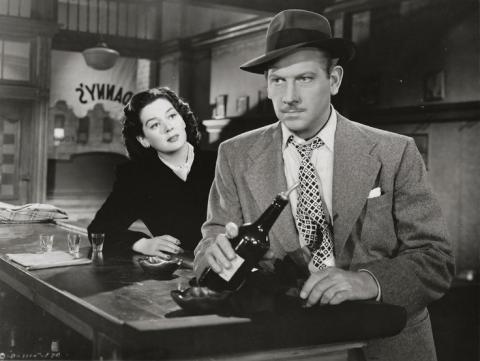THE GUILT OF JANET AMES: A Quintessential & Self-Reflexive "Psychological Picture"

THE GUILT OF JANET AMES
These notes on The Guilt of Janet Ames (1947) were written by Erica Moulton, PhD candidate in UW Madison’s Department of Communication Arts. A 35mm print of Janet Ames will screen in our Sunday Cinematheque at the Chazen series inspired by David Bordwell's new book, Reinventing Hollywood on February 25 at 2 p.m. at the Chazen Museum of Art.
By Erica Moulton
The Guilt of Janet Ames (1947) is a film of its time, in every possible sense. It fits neatly into the tradition of the "psychological picture" that became so prevalent in late 1940s Hollywood. The psychological film could be considered an offshoot of the detective genre, with films like The Dark Mirror (1946), The Snake Pit (1948), and Whirlpool (1949) taking up the fractured psyches of women and enlisting male psychiatrists as brain sleuths, rummaging around in their heads for the origins of their neuroses. Perhaps the greatest stylistic and narrative influence on the film is Hitchcock's ode to Freud, Spellbound, released two years before The Guilt of Janet Ames, which inverts the male/female roles, but like Janet Ames, also espouses the power of psychoanalysis (or Hollywood's bastardized version of it) to rid people of their psychological woes. Spellbound featured Ingrid Bergman trying to cure Gregory Peck of his trauma-induced amnesia by analyzing his dreams (in a sequence designed in collaboration with Salvador Dali). In The Guilt of Janet Ames, we get Melvyn Douglas trying to cure Rosalind Russell of a guilt complex brought on by her husband's death in WWII.
While Ames faithfully adheres in many ways to schemas set up by previous psychological pictures, it is most notable for its unusual narrational strategies, which are enumerated in David Bordwell's new book Reinventing Hollywood: How 1940s Filmmakers Changed Movie Storytelling. The film begins with something of a jolt, as Russell's titular character is introduced looking at a bar from across a busy city street, only to be struck by a car moments later. Douglas' character, Smitty, an alcoholic journalist, discovers that his name is on a list that Janet was carrying with her when she had her accident. He pieces together that she is the widow of a man in his unit during the war, who sacrificed himself on a grenade to save his fellow soldiers. Both Janet and Smitty are reeling from their guilt surrounding this past event, but rather than using flashbacks, a common device in the psycho-drama, the filmmakers hit upon a new device that even gets a name in the film: the word picture.
Smitty proffers this psychoanalytic technique to Janet, inspired by the eponymous character from George du Maurier’s novel Peter Ibbetson, who Smitty explains "refused to let a prison cell make him stay put." Bordwell observes that "this literary parallel motivates the premise that Janet in her wheelchair can mentally visit David's far-flung comrades. But the film also draws on a second aspect of du Maurier's tale: that a man and a woman could sustain their love by entering one another's dreams... it posits a shared fantasy [between Smitty and Janet]" (336). This shared fantasy is expressed in a series of mental projections, which Smitty calls "word pictures," that follow Janet as she confronts each of the five men on her list. This atypical narrational device is buoyed by distinctive stylistic choices: each "word picture" is expressed with a unique visual look designed to elicit a response from Janet as she begins to confront her marital problems.
Art director Stephen Goosón (who designed the infamous hall of mirrors in The Lady from Shanghai in the same year as Ames) clearly drew inspiration from Spellbound for the first fantasy sequence that takes place in a cocktail lounge, with its shadowy corners and warped silhouetted patrons. The distinctive style of each "word picture" sequence peels the corners of Janet's psyche back a little farther until she has nothing left to hide. Unsurprisingly, in her vulnerable state, she begins to fall in love with Smitty, and at the film's end, she paints a "word picture" of their shared future together.
A final note about the film—in addition to its novel narrative techniques, the film is also striking for the last "word picture" sequence that features a young Sid Caesar as a comedian who mocks the "psychological picture." Performing with a thick Austrian accent, Caesar presents himself as a famous Viennese psychoanalyst who consults with Hollywood producers on how best to depict mental ailments onscreen. This scene of jarring reflexivity doesn't seem to be reflected in the rest of the film proper, but it is telling that the filmmakers were sure that audiences in 1947 would be familiar enough with the sub-genre that they would get the joke. And even more remarkable still that despite including an extended scene mocking the psycho-drama, they would make a film that hit every predictable beat of the psycho -drama, including the rather improbable romantic finale.
